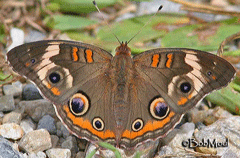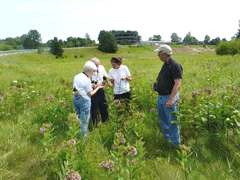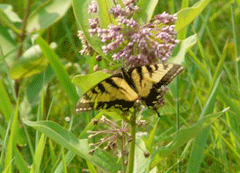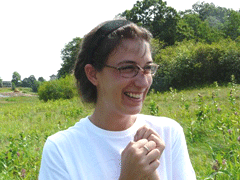The Butterfly Effect
Air Date: Week of September 12, 2008

For the first time, volunteers on the Concord Count spotted a Common Buckeye, a brushfooted butterfly usually found on the West Coast. (Photo: Bob Moul)
As mysterious diseases threaten bats and bees, scientists have now started studying alternate pollinators like butterflies to get an indication of the environmental health of areas around the United States. Producer Kim Gittleson went to Concord, Massachusetts to participate in one of the oldest butterfly counts and get the inside scoop on how these essential pollinators are coping in the face of increased habitat destruction.
Transcript
GELLERMAN: It’s Living on Earth, I’m Bruce Gellerman. For the past 34 years, members of the North American Butterfly Association have been heading for forests and fields, binoculars and nets in hand, to count the fluttering insects during their flights of fancy.
The day-long hunts in the summer and fall provide valuable data about the numbers and varieties of butterflies in an area. Typically there are more than 450 counts held a year in North America. Recently one set off from Concord Massachusetts, and that’s where Living on Earth’s Kim Gittleson went out for the count.
[CROWD SOUND]
WALTON: First of all, I’d like to welcome you all to the 20th annual Concord butterfly count!

LOE's Kim Gittleson interviews the team about their findings at Davis Farm. (Photo: Bruce Gellerman)
GITTLESON: Dick Walton stands in front of a crowd of 20 butterfly enthusiasts, packed like sardines in his living room. In the center of the room a champagne bottle covered in glittery butterfly stickers sits on a table, to commemorate the 20th anniversary of the Concord Butterfly Count.
WALTON: As usual, we’ll also have a special door prize for the best non-lep critter…
GITTLESON: Walton is somewhat of a rock star to this audience. He’s not only written a handful of guides to Massachusetts butterflies, he’s also the founder of the Concord count. Today, as he’s done for the past two decades, Walton orchestrates the event.
WALTON: Okay we’re gonna have four teams and, Marge you’re in charge of the Acton team, Eric, Sudbury, Wayland.
GITTLESON: The teams look over maps and plot out paths. They alert each other to special areas.
[SOUND OF COMMUNITY GARDENS]
GITTLESON: and to special butterflies.
WALTON: Oh, I wanted to tell you, there are Edward’s Hair Streaks on the entrance road before the one you usually go in.
GITTLESON: But it’s not just about looking for the prettiest butterfly of the bunch. Butterfly counts are meant to provide a survey of both numbers and species variation. Walton points to a spreadsheet on a large computer monitor.
WALTON: Insect populations in general, and butterflies specifically, have good years and bad years. And so throughout this data you’ll see very large numbers or very small numbers that indicate that for that year populations were either large or small.
GITTLESON: The numbers from today’s count will be totaled, and entered into the spreadsheet. This data is then sent off to the North American Butterfly Association. NABA compiles the data from counts held across the nation and publishes the results in the spring.
[DOOR SLAM; WALKING NOISES]
GITTLESON: Dick and three volunteers make their first stop at Verrill Farm, in Concord. The nature preserve and working farm is covered with ankle-high plants like vetch and daisies. This usually makes it a great place to spot lots of different butterfly species.
[SWISHING, BIRD SOUNDS]
WALTON: Typically in an open area like this, agricultural edge, we might well see swallowtails, monarchs, several skipper species, almost any butterfly really -- the painted lady, the American painted lady -- there are very few butterflies that we wouldn’t see here except for specific wetlands species.

For the first time, volunteers on the Concord Count spotted a Common Buckeye, a brushfooted butterfly usually found on the West Coast. (Photo: Bob Moul)
EICKELBERG: There are a couple of cabbage whites, one lit!
GITTLESON: Patsy Eickelberg shouts out the names of butterflies as she sees them. She trudges through the scrubby greenery gripping her butterfly net. Eickelberg says the net is perfectly engineered to make catching butterflies as easy, and as safe, as possible.
EICKELBERG: Basically they’re very easy, you can just come up underneath them, butterflies have a tendency, if you catch them on the bush, they have a tendency to drop, so if you come up under them you’re more likely to get them. That way you’re not swatting at them and possibly damaging, hurting them in some way.
[WALKING SOUND; SOME TRAFFIC]
SHETTERLEY: Only one cabbage white, one orange sulfur, and two clouded sulfurs]
GITTLESON: After about 45 minutes of combing the fields, Jay Shetterley and Dick Walton discuss their findings.
WALTON: All in all, a poor showing. Normally we see more butterflies just flying around here.
SHETTERLEY: Ten years ago I would say we had eight or nine species here, pretty good numbers.
WALTON: Yup, I think that’s right. We may be talking about just today, it is still a little cloudy out, but it seems thin even for the conditions. What’s your feeling, Jake?

A hungry butterfly feeds on milkweed at Davis Farm. (Photo: Bruce Gellerman)
GITTLESON: While Verrill Farm does use pesticides, it does so under Integrated Pest Management. IPM is a pest control strategy that uses an ecological approach to try and reduce the use of pesticides. The 200 acres that make up Verrill Farm use minimal amounts of chemicals, but there’s no telling what’s happening in nearby Concord farms.
[TRACTOR NOISES]
WALTON: As we were driving here, there was a tractor in front of us with a large plastic container on it and both Patsy and I noticed the odor. It didn’t pull into these fields but we don’t know where it was going and I certainly have seen tractors spraying herbicides and pesticides, and all of those things affect particularly insect life in any area.
GITTLESON: After tallying up the few butterflies they spotted, the team heads about five miles down the road to Davis Farm - a more rustic area filled with wildflowers that they know has not been sprayed with pesticides.
[DOOR SLAM]
WALTON: What d’ya got, John? Oh a silver spotted skipper on the queen Anne’s lace?
GITTLESON: Almost as soon as the volunteers step out of their cars, they spot a variety of butterflies.
[THE SWOOSH OF THE GRASS UNDERNEATH]
WALTON: and we’ve had a tiger swallowtail, a great spangle fritillary, did you see another skipper Jake?
GITTLESON: It’s soon easy to see what made the difference: milkweed. Milkweed is a plant that is poisonous to most animals, but useful to the family of butterflies that include monarchs. Their caterpillars feed on the cardioglycoside - a milky white substance - that runs through the veins in the plant’s leaves. This protection is then worn like a shield - and it makes butterflies like the monarch toxic to predators. Here in the field near Davis farm, the fuzzy pink blossoms of the plant are dotted with creatures of all sorts. Again, Dick Walton:
WALTON: Obviously Monarchs feed on the milkweed itself, but many butterflies use the blossoms to nectar. In Canada people are encouraged to pull up and destroy milkweed. The government has incentive programs and that’s the kind of thing that really does hurt butterflies.
GITTLESON: And milkweed destruction is not just happening in Canada – up on the hill above the Davis farm, a large office building looms, the cleared out lot around it perhaps a premonition of the fate that could befall the rest of this butterfly haven. The destruction of butterfly habitat and the resulting decline in population could have far reaching effects.
WALTON: Butterflies are critical to pollinating wildflower species and keeping our native habitats intact.
GITTLESON: As other pollinators like bats and bees are increasingly threatened by mysterious diseases, many scientists are studying alternate pollinators like butterflies and moths. Counts like this one hold the key to understanding whether population fluctuations indicate a crisis or simply a cycle of nature. Dick Walton says the jury’s still out for butterflies:

Patsy Eickelberg placed a dragonfly on LOE's Kim Gittleson. It stayed there until forcibly removed, which is a sign of good luck and future marriage proposals according to the volunteers. (Photo: Bruce Gellerman)
WALTON: I sense that insect populations are very plastic and given the right conditions they are able to, after a bad year, come back and repopulate an area. The real critical problem is habitat destruction.
GITTLESON: The final tally for this day turns out to be about average: 38 species and 590 individual butterflies were spotted. But counting butterflies is about more than just numbers. Novelist Vladimir Nabokov, who was also a well-known butterfly collector, once said that other than writing, butterflies were among the most intense pleasures known to man - and Patsy Eickelberg agrees.
EICKELBERG: To hold a butterfly in your hand, and see how fragile, and what a beautiful part of nature that is, it’s just an amazing thing for me, it’s kind of a life giving thing.
GITTLESON: For Living on Earth, I’m Kim Gittleson in Concord, Massachusetts.
[MUSIC: Bishop Allen, “Butterfly Nets:” “armed with a small butterfly net only/I will face the world alone and never be lonely.” ]
GELLERMAN: For more information on butterfly conservation, go to our website loe.org.
Links
Want to count butterflies? Check out the website of the North American Butterfly Association.
Living on Earth wants to hear from you!
Living on Earth
62 Calef Highway, Suite 212
Lee, NH 03861
Telephone: 617-287-4121
E-mail: comments@loe.org
Newsletter [Click here]
Donate to Living on Earth!
Living on Earth is an independent media program and relies entirely on contributions from listeners and institutions supporting public service. Please donate now to preserve an independent environmental voice.
NewsletterLiving on Earth offers a weekly delivery of the show's rundown to your mailbox. Sign up for our newsletter today!
 Sailors For The Sea: Be the change you want to sea.
Sailors For The Sea: Be the change you want to sea.
 The Grantham Foundation for the Protection of the Environment: Committed to protecting and improving the health of the global environment.
The Grantham Foundation for the Protection of the Environment: Committed to protecting and improving the health of the global environment.
 Contribute to Living on Earth and receive, as our gift to you, an archival print of one of Mark Seth Lender's extraordinary wildlife photographs. Follow the link to see Mark's current collection of photographs.
Contribute to Living on Earth and receive, as our gift to you, an archival print of one of Mark Seth Lender's extraordinary wildlife photographs. Follow the link to see Mark's current collection of photographs.
 Buy a signed copy of Mark Seth Lender's book Smeagull the Seagull & support Living on Earth
Buy a signed copy of Mark Seth Lender's book Smeagull the Seagull & support Living on Earth

